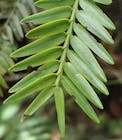Conservation Status

Retrophyllum comptonii
(Buchholz) Page 1989
Common names
Taxonomic notes
Syn: Podocarpus comptonii J. Buchholz 1949; Decussocarpus comptonii (J. Buchholz) de Laubenfels 1969; Nageia comptonii (J. Buchholz) de Laubenfels 1987 (Farjon 1998). Holotype: Buchholz 1684 (ILL) (de Laubenfels 1972).
Description
Trees, up to 30 m tall. Bark light to brown-gray darkening with age, fibrous, rough and fissured on old trees, exfoliating in short, vertical bands or in coarse fragments. Leafy branchlets opposite or alternate on leafless branchlet; either one of several on top of old leafy branchlets in the axils with one or two spreading scales. Leafless branchlets with the dispersed, spreading scales, are coriaceous, roundish, 1-2 mm long on young plants and 4 mm like the small leaves on fertile specimens. Leaves of young plants distichous and equally twisted at their base, lanceolate with a soft tip; the distinct midrib on the lower surface has a narrow, sharp ridge, and on the upper surface has a fine groove, 30×6 mm. Adult leaves oval-lanceolate, 6-15 × 2.5-4 m, becoming non distichous but always equally turned, coriaceous; the distinct midrib has a narrow raised band; the edges of the bands dry to form two parallel ridges on each of the two faces. Pollen cone isolated in the leaf axils, or occasionally 1-5 cones together on a specialized shoot which is lateral on a leafless branchlet, or terminal on a leafy branchlet. Microsporophyll short, triangular with the pollen sack open showing the big spreading edges. Seed cone oval, 4-6(-12) mm long, 2.5-3 mm in diameter, terminal on branchlets with or without leaves, consisting of 2-3 decussate, spreading scale bracts, following by two uneven bracts of which one is fertile; occasionally, both are fertile. Micropyle of the ovule inverted, the tip of the beak long, extending approximately 2 mm below the fertile spreading bracts, the fertile scale completely enclosing the ovule and forming an apical ridge that only persists on the ripe fruit. Seed globose, pear shaped, 20 mm long, includes a curved beak, 13-15 mm diameter, covered by a fleshy, glaucous scale 2-3 mm thick, which becomes deep red at maturity, the surface of the seed denticulate, slightly elevated on the crests (de Laubenfels 1972).
Distribution and Ecology
New Caledonia (Farjon 1998). Occurs in ombrophilous forests throughout the main island at elevations of 750-1450 m (de Laubenfels 1972). Based on data from 50 collection localities, its climate preferences include a mean annual temperature of 20°C, with an average minimum in the coldest month of 13°C, and a mean annual precipitation of 1830 mm (Biffin et al. 2011, Table S5).
This map shows herbarium records of Retrophyllum species native to New Caledonia. Red is R. comptonii, and blue is R. minus. Click on an icon for further information. Distribution data from GBIF (2020.03.30), edited to remove duplicates.
This species, with Falcatifolium taxoides and Araucaria montana, are the most common conifers in New Caledonia (de Laubenfels 1972). De Laubenfels (1972) records collections at Bourail above Téné, Ignambi (110-1200 m), Mois de Mai, Mt. Des Sources (600 m), Mt. Dzumac (800-1000 m), Mt. Humboldt, Mt. Mou, Mt. Paéoua (900 m), Rivière Bleue, and vallée de la Quinné (700-900 m).
The IUCN reports that the population status is stable.
Remarkable Specimens
No data as of 2023.02.22.
Ethnobotany
No data as of 2023.02.22.
Observations
No data as of 2023.02.22.
Remarks
The epithet honors the original collector, R. H. Compton, who collected on New Caledonia in 1914 (Buchholz 1949; q.v. Compton 1917).
Citations
Buchholz, J. T. 1949. Additions to the coniferous flora of New Caledonia. Bull. Mus. Natl. Hist. Nat. (Paris), Sér. 2, 21(2):279–286. Available: Biodiversity Heritage Library, accessed 2020.02.10.
Compton, R. H. 1917. New Caledonia and the Isle of Pines. The Geographical Journal 49(2):81-103.
Thanks to Ferenc Kiss for translating de Laubenfels' text from the French (2006.11.16).
See also
Association Endemia, a site devoted to New Caledonian species. Has excellent photos, a range map, and other information. In French.
Mill (2016), a very comprehensive monograph of Retrophyllum.
Sarlin. 1954. Bois et Forêts de Nouvelle. Calédonie p. 93, tab. 26.
Gray, N. E. 1962. A Taxonomic Revision of Podocarpus. XIII. Section Polypodiopsis in the South Pacific. Journal of the Arnold Arboretum 43:67-79. Available: Biodiversity Heritage Library, accessed 2021.12.19.
Dallimore et al. (1967): p. 517-518.




